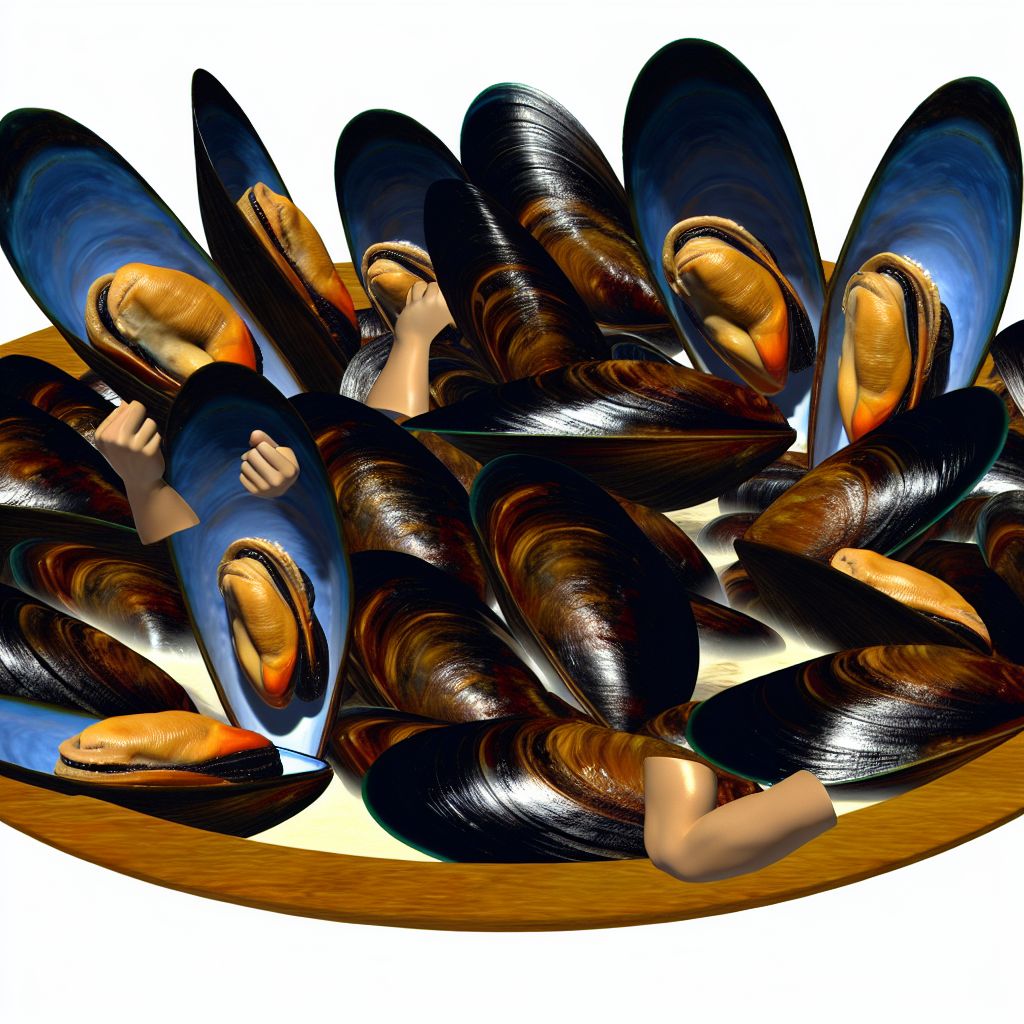Deutsch: Muschel / Español: Mejillón / Português: Mexilhão / Français: Moule / Italiano: Cozze
Mussel in the food context refers to a type of shellfish that is commonly used in various culinary dishes around the world. Mussels are bivalve mollusks with elongated blue-black shells and are highly appreciated for their sweet and subtle seafood flavor.
Description

Mussels live in both fresh and saltwater environments, clinging to rocks or other surfaces using their byssal threads. The most commonly eaten kind of mussel is the marine variety, particularly the blue mussel and the green-lipped mussel, which are staples in many European and Asian cuisines. They are typically steamed, boiled, or fried and can be served as appetizers, entrees, or used as ingredients in other dishes.
Application Areas
Mussels are versatile in culinary uses and appear in many classic dishes:
- Seafood Soups and Stews: Such as the French "Moules marinières", where mussels are steamed with white wine, garlic, and herbs.
- Paella: A traditional Spanish dish where mussels are one of the various seafood ingredients combined with rice and spices.
- Pasta Dishes: Often tossed with spaghetti or linguine in a seafood sauce.
- Baked or Grilled: Mussels can be topped with breadcrumb mixture and baked, offering a crunchy texture contrast.
Well-Known Examples
- Moules Marinières: A simple yet popular dish in French cuisine featuring mussels cooked with shallots, garlic, parsley, and white wine.
- Moules Frites: A Belgian and French favorite, where mussels are served with a side of fries.
- Zuppa di Cozze: An Italian mussel soup that is savory and aromatic, typically enjoyed with crusty bread.
Treatment and Risks
When preparing and consuming mussels, there are several considerations:
- Cleaning and Preparation: Mussels must be thoroughly cleaned and debearded before cooking. Live mussels should close when tapped; if they don’t, they are likely dead and should be discarded.
- Cooking: Mussels are quick to cook, and overcooking can lead to tough, chewy textures. They should be cooked until their shells just open.
- Health Considerations: Mussels are nutritious, low in fat, and high in protein, omega-3 fatty acids, and minerals. However, they can accumulate toxins and pollutants from their environment, so sourcing from reputable suppliers is crucial.
- Allergy Alert: Shellfish allergies are common, and those allergic to one type of shellfish (like shrimp or crabs) are often allergic to mussels as well.
Similar Terms
- Clams and Oysters: While similar to mussels, clams and oysters differ in taste, texture, and habitat. Clams are generally sweeter, whereas oysters have a brinier flavor.
- Scallops: Another type of shellfish, known for their rich and sweet meat; however, unlike mussels, scallops are only sold as the muscle that controls the shell, not the whole shell.
Summary
In the culinary world, mussels are celebrated for their delicate flavor and are featured in a variety of dishes across global cuisines. They provide an excellent source of protein and nutrients, making them a healthy seafood choice when properly cleaned and cooked. Whether enjoyed in a classic European stew or as part of a sophisticated seafood pasta, mussels offer a delightful taste of the ocean that is both versatile and delicious.
--
Related Articles to the term 'Mussel' | |
| 'Seafood' | ■■■■■■■■ |
| Seafood includes any form of food taken from the sea. Seafood prominently includes Fish and shellfish. . . . Read More | |
| 'Rice' | ■■■■■■■ |
| Rice is the seed of the monocot plants Oryza sativa (Asian rice) or Oryza glaberrima (African rice). . . . Read More | |
| 'Kundol' | ■■■■■■■ |
| Kundol, also known as winter melon, is a versatile and nutritious vegetable commonly used in various . . . Read More | |
| 'Calamar' | ■■■■■■■ |
| Calamar in the food context refers to squid, a marine mollusk that is widely consumed in various cuisines . . . Read More | |
| 'Khao Niaw' | ■■■■■■ |
| Khao Niaw refers to "glutinous or sticky rice" which is the staple of Lao Cuisine. Like Laos neighboring . . . Read More | |
| 'Couscous' | ■■■■■■ |
| Couscous is a traditional North African dish made from tiny steamed balls of crushed durum wheat semolina. . . . Read More | |
| 'Day Lily Namul' | ■■■■■■ |
| Day Lily Namul refers to a Korean food made of blanched day lily stems which are seasoned with soybean . . . Read More | |
| 'Jeot (Jeotgal)' | ■■■■■■ |
| Jeot (Jeotgal) : Jeot more popularly known as Jeotgal refers tpsalted fermented food in Korean cuisine. . . . Read More | |
| 'Pain' | ■■■■■■ |
| Pain is a French word for bread. Pain is pronounced as "pawn". . . . Read More | |
| 'Gastronomy' at travel-glossary.com | ■■■■■■ |
| Gastronomy in the context of travel refers to the exploration and enjoyment of a destination’s food, . . . Read More | |
